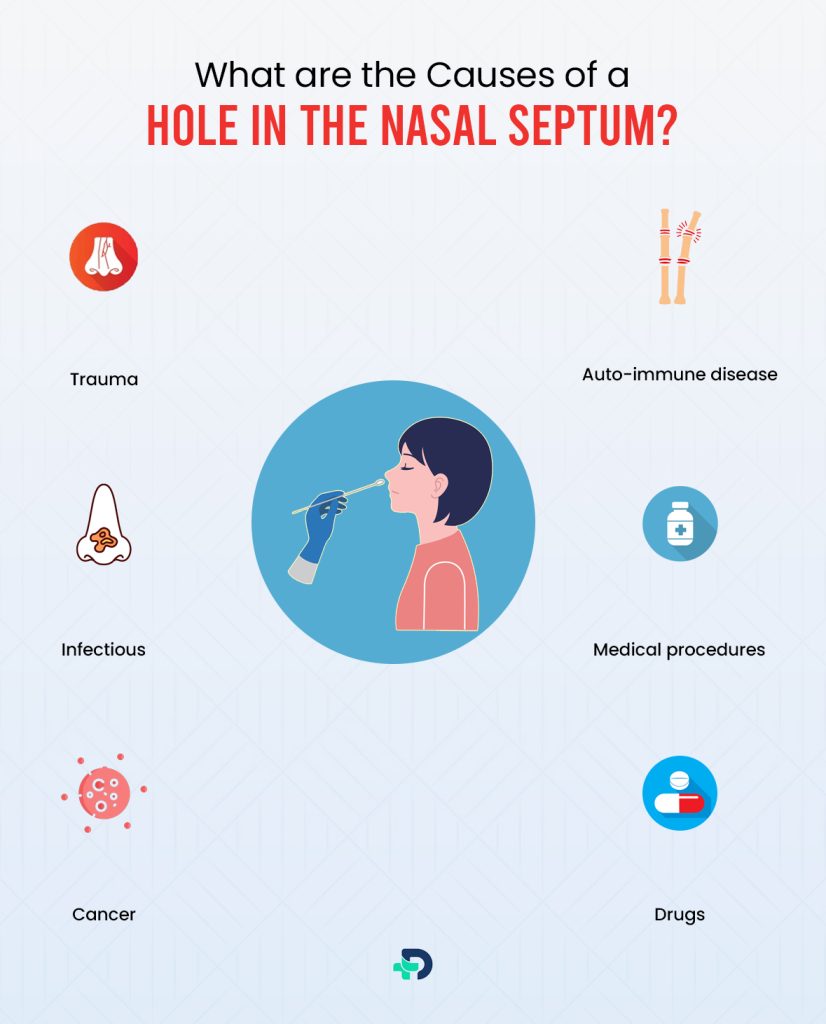Hole In The Septum – All About Nasal Septum

- Nose
- 22 Sep 2023
Introduction
Nasal Septum
The nasal septum divides the nose into right and left nostrils. This septum is made of cartilage and directs airflow into the nostrils. When this septum gets injured, it may lead to the development of a hole. This situation is known as nasal septal perforation. The hole is frequently present at the front of the septum and leads to a wide range of symptoms that can vary from mild to severe. If the size of the hole increases, the symptoms can worsen, which can negatively affect your quality of life.

Nasal septal perforation is present in about 1 out of 100 people 1 Nasal Septal Perforation | Researched based study from National Institutes of Health . Certain factors could increase the risk of having a nasal septal perforation, such as prolonged exposure to chemicals like chrome, mercury, and nickel dust 2 Septal Perforation | Researched based study from National Institutes of Health . To date, various treatments have helped manage nasal septal perforation and improve your quality of life. Read on to broaden your knowledge about the causes, symptoms, diagnosis, and management of nasal septal perforation.
Causes

What are the Causes of a Hole in the Nasal Septum?
There are many reasons you could get a hole in your nasal septum. They may include:
- Trauma – A nose trauma, such as a fracture, chemical irritation, or obstruction by a foreign object, can cause a nasal septal perforation.
- Auto-immune disease – Some auto-immune diseases—disease conditions in which the body’s fighting cells attack your own cells—like granulomatosis with polyangiitis (GPA), lupus, and rheumatoid arthritis canlead to a hole in the nasal septum 3 Causes | Researched based study from Europe PubMed Central .
- Infectious – If you contract a disease such as syphilis, a fungal disease, or tuberculosis, there are chances you may develop a nasal septal perforation. You may have a higher risk of opportunistic infections, such as fungal infections, if you are infected by the Human Immuno-Deficiency Virus or have any other disease that weakens the immune system.
- Cancer – Cancer of the nasal septum is very rare but can cause a perforation. Certain cancer drugs can injure the nasal septum and cause the development of a hole. Your healthcare provider will closely monitor you for a nasal septal perforation if you are treated with cancer drugs that can injure the nasal septum.
- Medical procedures – If you have had previous surgery on the nose, you may have a nasal perforation a few weeks or months later. Also, coagulating blood and destroying nose tissue with a hot device (cauterization) while managing a nosebleed can favor a nasal septal perforation.
- Drugs – Intranasal drug abuse may lead to a nasal septal perforation. This is common with cocaine use. Besides, some nasal sprays, especially those containing steroids, can lead to a nasal septal perforation because they cause a thinning of the nasal septal mucous membrane. Contact your healthcare provider before using nasal spray.
Symptoms
What are the Symptoms of a Hole in the Nasal Septum?
You can experience different types of symptoms that may be mild, moderate, or severe, depending on the size of the hole.
Some of the symptoms may include 2 Symptoms| Researched based study from National Institutes of Health :
- feeling of obstruction in the nose
- whistling as air flows through the nostrils during rest, sleep, or exercise.
- bleeding from the nose
- having a runny nose with nose pains
- crusting of the nose
- having a foul smell in the nose
Consult your healthcare provider if you have a hole in your nasal septum and experience any of these symptoms. He may ask you questions about the onset, duration, and severity of the symptoms and examine you to assess the size of the hole. Small holes measure less than 5 mm, medium-size holes vary from 5 mm to 20 mm, and large holes measure more than 20 mm 2 Symptoms | Researched based study from National Institutes of Health . Thereafter, he may propose that you do some tests.
Diagnosis
What are the Diagnostic Tests for a Hole in the Nasal Septum?
When the cause is evident, for instance, a nasal septal perforation that appears after a nose surgery, no test is necessary. But when the cause is less clear, your healthcare provider may propose some tests and take a small piece of the perforated nasal septal tissue (biopsy) to analyze. These tests may include:
- Blood tests – Several blood tests are available to determine the cause of the nasal septal perforation. If your healthcare provider suspects you may have syphilis, he may prescribe you a fluorescent treponemal antibody absorption (FTA-ABS) test. On the other hand, if he suspects an auto-immune disease, he may prescribe you tests like the antinuclear antibody (ANA) test, the anti-neutrophil cytoplasmic auto-antibody (ANCA) test, the rheumatoid factor (RF), et cetera.
- Sputum test – Your healthcare provider may propose to do a sputum test if he suspects you may have tuberculosis. This will help identify the tuberculosis germ (a bacteria called Mycobacterium tuberculosis).
- Imaging tests – There are a variety of imaging tests that you can do for a hole in the nasal septum. Your healthcare provider may propose some imaging tests if he suspects a cause or thinks you might be having a complication from your nasal septal perforation. These include, but are not limited to, a chest X-ray or a computerized tomography (CT) scan of the nasal sinuses—air-filled cavities in the bones of the nose 2Imaging Tests | Researched based study from National Institutes of Health .
- Nose tissue test – A pathologist—a healthcare provider that specializes in tissue analysis—will analyze the piece of perforated nasal septal tissue to check for cancerous cells, germs, or signs of auto-immune diseases.
Complications
What are the Complications of a Hole in the Nasal Septum?
Having a nasal septal perforation can expose you to a variety of complications related to either the presence or surgical repair of the hole. These may include:
- Worsening of symptoms – Left untreated, the size of the hole may increase, and symptoms may worsen. These might require you to consult your healthcare provider.
- Crusting – The exposed edges of the hole make the septum dry and prevent inhaled air from getting humidified. As a result, crusts start forming along the nasal septal perforation. These crusts may increase your chances of having a nosebleed and contribute to further enlarging the hole.
- Nosebleed – The disturbed airflow due to the hole in the septum makes the nostrils dry. As a result, the mucous membrane of the nostrils becomes fragile and prone to bleeding.
- Nasal obstruction – You might have the impression of a nasal obstruction because the perforated nasal septum fails to properly direct air into the nostrils. This may worsen as the size of the hole increases.
- Donor site scar – In the course of surgery, your healthcare provider may have to take some tissue from another part of the body, called the donor site, to close the nasal septal perforation. This can leave that body part with a scar.
- Wound breakdown – Poor wound healing of the hole after surgery may lead to a wound breakdown, causing the hole to reappear. Wound breakdown is common for large holes (greater than 20 mm) compared to small and medium-size holes and may be due to the careless use of nasal sprays, nasal dryness, nose picking, et cetera.
- Nose deformity – As the nasal septal perforation worsens, the nasal bridge may weaken, become deformed, and collapse. This leads to a nose deformity called saddle nose.
- Ozena – Ozena, also known as atrophic rhinosinusitis, is a rare complication of nasal septal perforation in which the bony ridges and mucous membrane of the nose waste away 4 Complications | Researched based study from Medline Plus .
Management
What are the Management Options for a Hole in the Nasal Septum?
Although drugs are available to help manage the symptoms of nasal septal perforation, surgery is the definitive treatment. Depending on the size of the hole, there are various surgical options for repair. Due to its variety of causes, several healthcare providers may collaborate during the management of nasal septal perforation: a rheumatologist (bone specialist), an oncologist (cancer specialist), an ear, nose, and throat (ENT) surgeon, an infectiologist (infectious disease specialist), and a psychiatrist (mental disorder specialist). The drugs used to manage nasal septal perforation may include:
- Humidifiers and Emollients – They humidify the nasal septal mucosa and can help reduce discomfort, crusting, and nosebleeds. You may install a humidifier in your home to humidify the air or use a nasal spray. Emollients such as Ponaris oil and Vaseline ointment can help relieve the symptoms.
- Petroleum-containing products – Petroleum-containing products, such as petroleum jelly, can be used to relieve nose dryness and prevent crusting. However, be cautious when using these products inside the nose to minimize aspiration and subsequent lipoid pneumonia (irritation of the lung air sacs due to fat) 2 Management| Researched based study from National Institutes of Health .
Water-based gels and sprays are typically safer. Discuss with your healthcare provider which treatment option is suitable for you. By reducing the symptoms of nasal septal perforation, these drugs improve the quality of life both before and after surgical repair.
Surgical Repair
How does Surgical Repair of a Hole in the Nasal Septum take place?
Septoplasty is the surgical repair of the nasal septum. The aims of septoplasty are to close the hole, reduce the symptoms, and improve your quality of life.There are several options available for surgical repair, depending on the size of the hole.
Surgical repair options include:
- Using medical-grade synthetic material called prostheses to cover the nasal septal perforation. They are generally safer because the rate of infection of the prosthesis is low 2 Surgical repair | Researched based study from National Institutes of Health .
- Taking a neighboring or remote piece of tissue from another part of the body to close the nasal septal perforation. Small holes can be covered by tissue from the nose, ear, or mouth, while medium-sized to large holes may require larger flaps taken from the scalp.
Some nasal septal perforations may require a two-stage procedure and/or multiple interventions, depending on the complexity of the perforation. After surgical repair, your healthcare provider will give you some advice about nasal hygiene to avoid wound breakdown and relapse of the nasal septal perforation.
Advices include;
- Avoiding the use of nasal sprays that can irritate the nasal mucosa and predispose to nasal septal perforation. Sprays that contain steroids should be avoided, as they cause thinning of the nasal septal mucous membrane. Seek advice from your healthcare provider or pharmacist before using nasal sprays after surgical repair of the nasal septum.
- Using humidifiers and emollients that help keep the nasal septal mucosa humid. This prevents crusting and nosebleeds.
- Minimizing nasal manipulation such as nose picking, applying pressure to the nose, et cetera.
- Avoiding nose blowing and minimizing sneezing for about a month after surgical repair of the nasal septal perforation to allow time for proper healing.
Outlook
Nasal Septal Perforation – An Outlook
In conclusion, nasal septal perforation may impair your general well-being with symptoms that could be mild, moderate, or severe. To date, several treatment options are available to help manage the symptoms, and surgery remains the definitive treatment for nasal septal perforation.
Takeaways
Nasal Septal Perforation – Key Takeaways
If you have lost track while reading this article, no worries; here are some key points to remember:
- Nasal septal perforation is the presence of a hole in the nasal septum and affects about 1 out of 100 people. Some professions, such as those in which you manipulate mercury, chrome, and nickel dust, are more at risk than others.
- Several causes, such as infections, auto-immune diseases, trauma, cancer, drugs, and medical procedures, can lead to the development of a hole in the nasal septum.
- There are a variety of symptoms that may be mild, moderate, or severe, depending on the size of the hole.
- Your healthcare provider will prescribe you some tests (blood tests, sputum tests, and imaging tests) and may take a small piece of the perforated nose tissue for analysis if he suspects cancer, germs, or auto-immune diseases may be the cause of the perforation.
- Despite the possible complications, several treatment options, such as sprays, gels, and ointments, are available to relieve the symptoms. The definite treatment for nasal septal perforation is surgical repair, using either a synthetic material (prosthesis) or a piece of tissue from another part of the body.
- After surgical repair, you should avoid nose picking, nose blowing, and nasal sprays, and make sure to humidify your nasal septal mucosa using the humidifiers or emollients prescribed by your healthcare provider or pharmacist.
Any feedback on this article?
 This Articles content was accurate
This Articles content was accurate Very Informative Article
Very Informative Article I have a question or a comment
I have a question or a comment
 This article contains inaccurate content
This article contains inaccurate content This article was not helpful
This article was not helpful I have a question or a comment
I have a question or a comment
We appreciate your helpful feedback!
Checkout our social pages
References
-
National Institutes of Health
Nasal Septal Perforation
-
National Institutes of Health
Septal Perforation | Symptoms | Imaging Tests | Surgical Repair | Management
-
Europe PubMed Central
Causes
-
Medline Plus
Complications



































